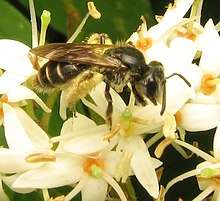Oligolecty
The term oligolecty is used in pollination ecology to refer to bees that exhibit a narrow, specialized preference for pollen sources, typically to a single genus of flowering plants. The preference may occasionally extend to multiple genera within a single plant family, or be as narrow as a single plant species. The opposite term is polylectic, and refers to species that collect pollen from a wide range of species. The best example is the domestic honey bee.

Such pollinators are often called oligoleges or simply specialist pollinators, and this behavior is especially common in the bee families Andrenidae and Halictidae, as well as the genus Ptilothrix. Under the family Andrenidae is the species Macrotera portalis, in which observations have suggested it is oligolectic. Macrotera portalis is a communal, ground nesting bee that has been found to preferentially pollinate certain host flowers of the same species.[1] Andrena agilissima is another oligolectic mining bee that prefers different types of wild mustard and radish plants.[2] Attempts have been made to determine whether this narrow host preference is due to an inability of the bee larvae to digest and develop on a variety of pollen types, or a limitation of the adult bee's learning and perception (i.e., they simply do not recognize other flowers as potential food sources), and most of the available evidence suggests the latter. However, a few plants whose pollen contains toxic substances (e.g., Toxicoscordion and related genera in the Melanthieae) are visited by oligolectic bees, and these may fall into the former category.
There are some cases where oligoleges collect their host plant's pollen as larval food, but for various reasons rarely or never actually pollinate the flowers. A well-studied example is the relationship between the Yellow Passionflower (Passiflora lutea) and the Passionflower Bee (Anthemurgus passiflorae) in Texas.
Further reading
- Proctor, M., Yeo, P. & Lack, A. (1996). The Natural History of Pollination. Timber Press, Portland, OR. ISBN 0-88192-352-4
References
- Robert John Paxton (2005). "Male mating behaviour and mating systems of bees: an overview" (PDF). Apidologie. 36 (2): 145–pp 156. doi:10.1051/apido:2005007.
- Giovanetti, Manuela; Luppino, Silvia; Zola, Rosanna (2006). "Preliminary note on the relative frequencies of two bees on wild Brassicaceae: oligolectic Andrena agilissima vs polylectic Apis mellifera". Bulletin of Insectology. 59 (2): 153–156.